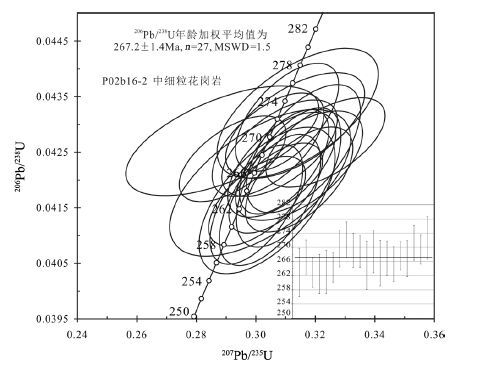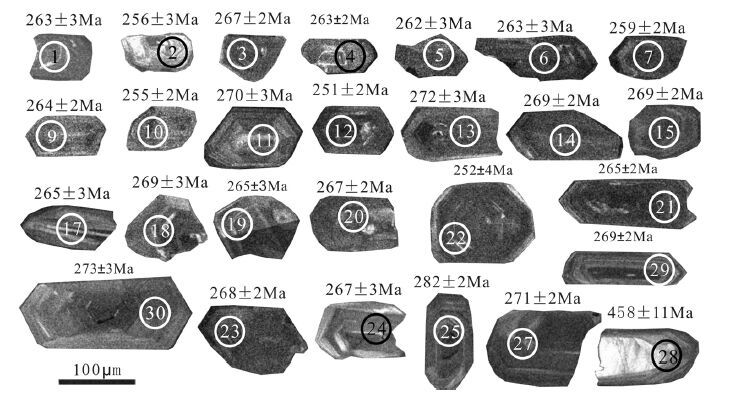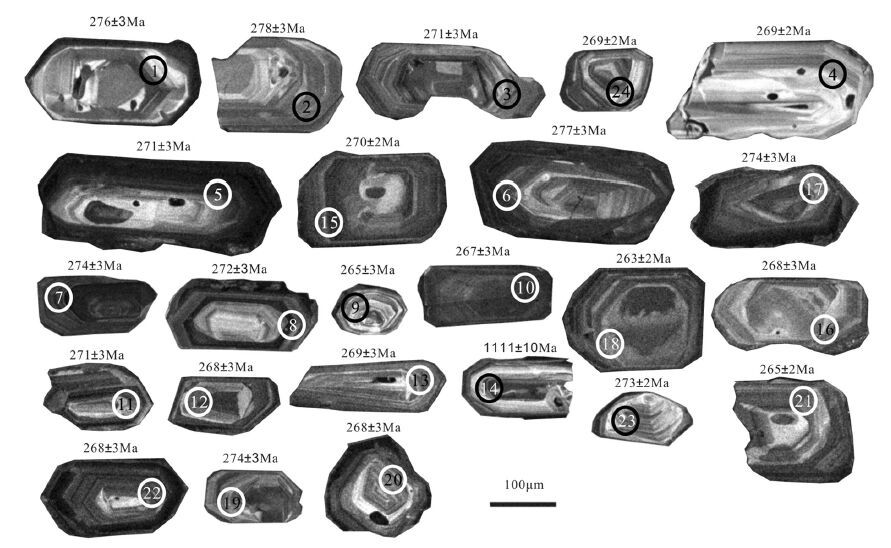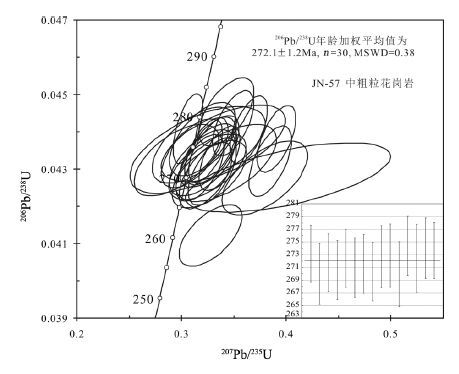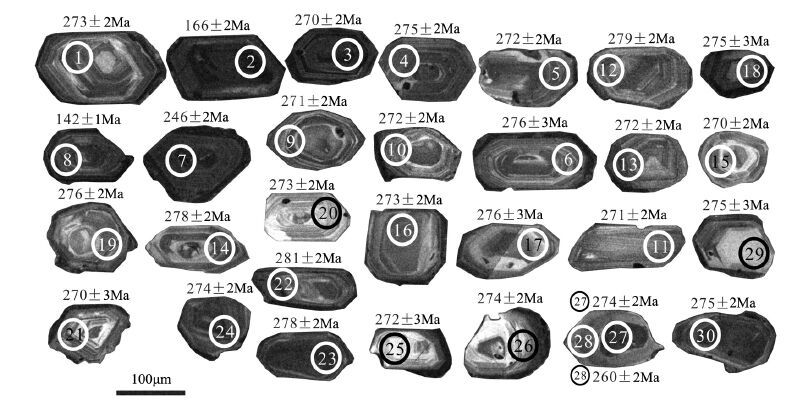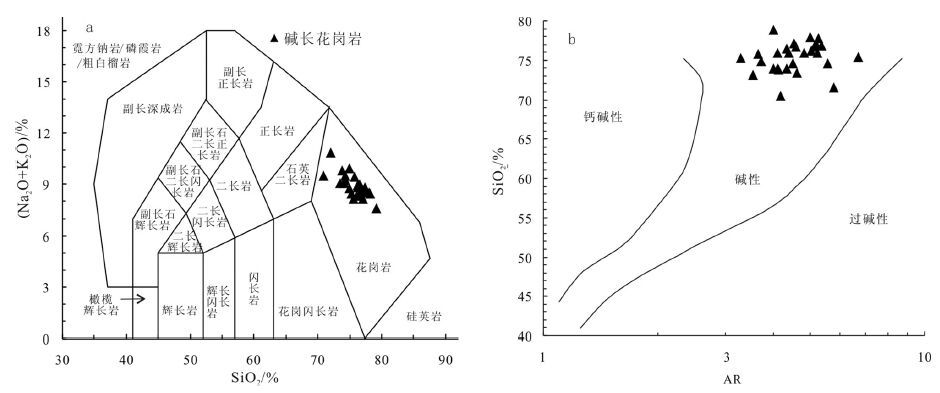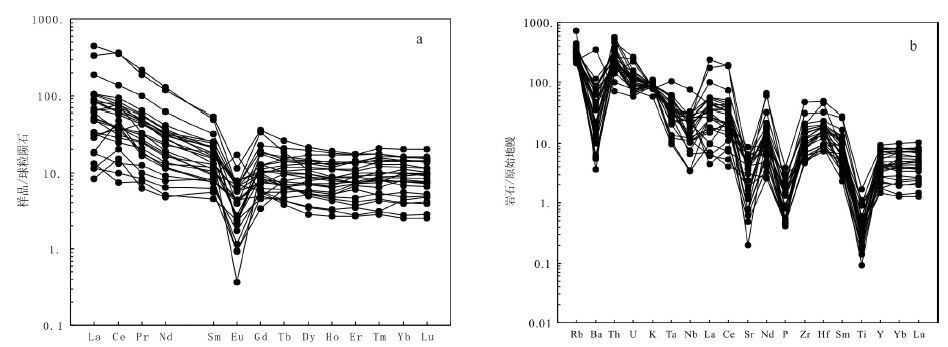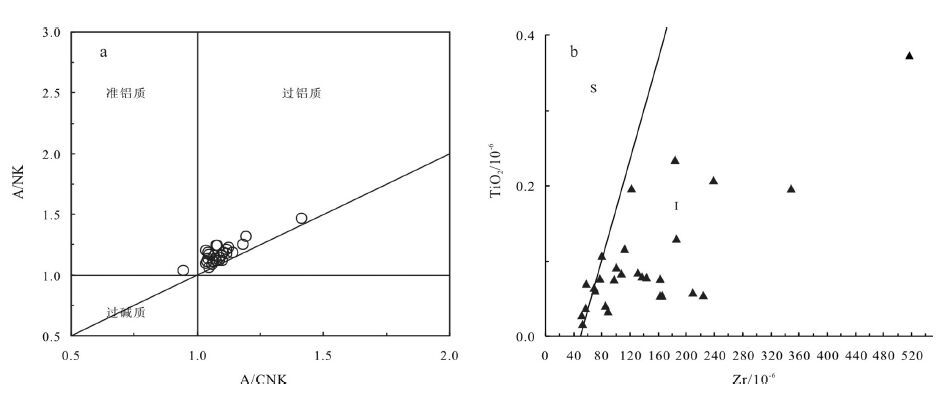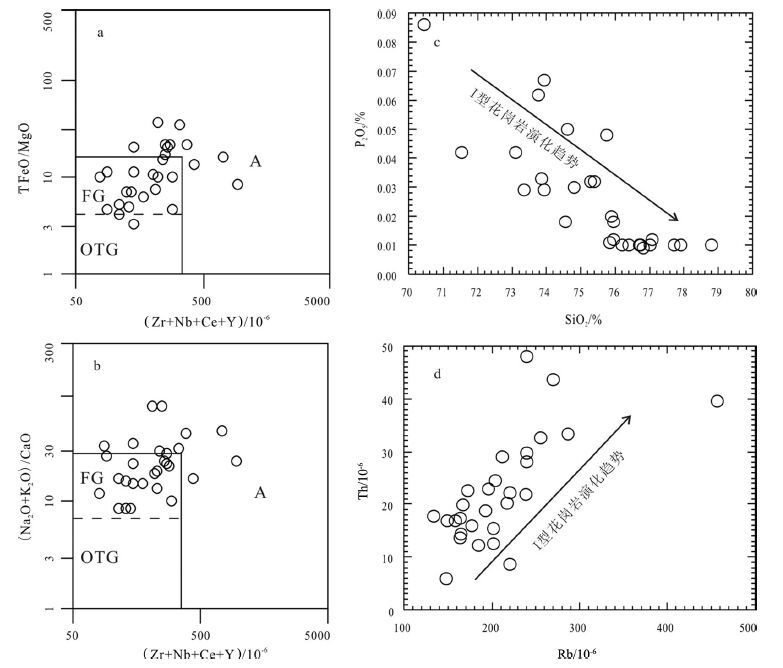Petrogenesis and tectonic setting of the granites in Honggeertu area, central Inner Mongolia: Constraints from LA-ICP-MS zircon U-Pb chronology and geochemistry
-
摘要:
内蒙古察右后旗红格尔图花岗岩岩体位于索伦缝合带以南,主要为正长花岗岩和二长花岗岩,富硅(70.44%~78.80%),富碱(7.46%~10.74%),贫镁、铁、钛等,A/CNK值在0.95~1.41之间,碱铝指数AKI值在0.68~0.97之间,碱度率AR值在3.30~6.68之间,为弱过铝质-过铝质类碱性系列花岗岩;稀土元素总量变化范围大,轻稀土元素富集,重稀土元素亏损,Eu呈负异常(δEu=0.03~0.89);富集高场强元素Th、U、Hf、Ta、Y等,亏损大离子亲石元素Sr、Ba、Eu等;高场强元素和值((Zr+Nb+Ce+Y)<350×10-6)明显偏低,该岩体属于高分异I型花岗岩,形成于后造山(后碰撞)伸展构造环境。LA-ICP-MS锆石同位素测年,获得锆石206Pb/238U年龄加权平均值分别为267.2±1.4Ma、269.2±1.6Ma和272.1±1.2Ma,表明该岩体形成于中二叠世,因此研究区内两大板块碰撞缝合的时间应该至少早于该岩体的形成时代,即应该至少早于267.2~272.1Ma。
Abstract:Honggeertu granites, located in central Inner Mongolia and belonging to southern Solon-Linxi fault, is mainly composed of middle-fine to middle-coarse grained syenite granites and monzonitic granites. These granites have high SiO2 (70.44%~78.80%) and are enriched in alkali (Na2O+K2O=7.46%~10.74%) but depleted in Mg, Fe and Ti. The A/CNK ratios are in the range of 0.95~1.41, alkali aluminum indexes (AKI) are 0.68~0.97, and alkalinities (AR) are 3.30~6.68, suggesting that the granites belong to weakly peraluminous-peraluminous alkaline series. The granite intrusion has widely varying total REE values (ΣREE=25.96×10-6~654.50×10-6), and is enriched in LREE and depleted in HREE with negative Eu anomaly (δEu=0.03~0.89). It is relatively enriched in high field strength elements (Th, U, Hf, Ta and Y) and depleted in large ion lithophile elements (Ba, Eu and Sr). The values of high field strength elements (Zr+Nb+Ce+Y) are higher than 350×10-6. The rocks belong to highly fractionated I-type granites formed in a post orogenic tectonic environment. Zircon LA-ICP-MS dating yielded 206Pb/238U weighted average ages, i.e., 267.2Ma±1.4Ma (MSWD=1.5), 269.2±1.6Ma (MSWD=1.7) and 272.1±1.2Ma (MSWD=0.38), indicating that the rock was formed in the Middle Permian. The new data suggest that the collision between NCC and Siberian Craton was earlier than the formation of the rock, and should be at least as early as 267.2~272.1Ma.
-
Keywords:
- Honggeertu granites /
- chronology /
- geochemistry /
- post-collision /
- structure /
- Inner Mongolia
-
研究区位于兴蒙造山带东段,由北向南依次为额尔古纳地块、兴安地块和松嫩地块,经历了古生代多块体拼合作用过程和中生代陆内演化过程的叠加,地壳结构、构造相对复杂[1-2]。大兴安岭北段发育大面积的晚中生代火山岩,由于研究区内火山岩研究对象不同,众多学者对火山岩期次的划分与厘定存在分歧。关于火山岩形成的构造环境问题存在争议,先后有地幔柱成因[3-4]、板内成因[5]、蒙古-鄂霍茨克洋俯冲成因[6-8]、古太平洋俯冲成因[9-10]等多种观点。另一方面,大兴安岭北段的中西部地区目前有较多的年代学资料,但东部地区火山岩年代学及火山岩构造背景的研究较滞后。因此,本文对研究区不同期次火山岩开展详细的研究工作,进一步划分火山岩浆活动期次,讨论火山岩的成因及形成的构造环境,为晚中生代火山岩的构造环境提供依据。
1. 地质背景及岩石学特征
龙江盆地位于黑龙江省龙江县境内,内蒙古自治区东部,所在区域为古生代陆壳侧向增生区,亦为兴安地块和松嫩地块的缝合区(图 1-a)。在地质特征上,龙江盆地是由多个发育在海西褶皱基底上,以早白垩世为主体的一群中小规模的断陷湖盆组合而成,形成条件相近的断陷,具有各自独立的沉积体系。
![]() 图 1 大兴安岭北部构造单元划分[11](a)和龙江盆地地质简图(b)Figure 1. Tectonic setting map of the northern Da Hinggan Mountains (a) and simplified geological map of Longjiang basin(b)
图 1 大兴安岭北部构造单元划分[11](a)和龙江盆地地质简图(b)Figure 1. Tectonic setting map of the northern Da Hinggan Mountains (a) and simplified geological map of Longjiang basin(b)区内出露的地质体主要包括晚古生代大石寨组、花岗岩体及晚中生代火山岩。其中,大石寨组为一套经过低级变质作用改造的火山-沉积岩系[12],其形成环境为浅海并伴随较强烈的火山活动;花岗岩主要由花岗闪长岩和二长花岗岩组成,为一套高钾钙碱性系列岩石。盆地内出露的晚中生代地层自下而上为下白垩统龙江组、光华组和甘河组,是大兴安岭北段火山盆地的基本类型。龙江组为偏中性火山岩,以安山岩、安山质凝灰岩、火山角砾岩、凝灰质细-粉砂岩夹少量英安岩、英安质凝灰岩为主,与下伏二叠系和侵入岩呈角度不整合接触。光华组为偏酸性火山岩,以流纹岩、碱流岩、流纹质凝灰岩、流纹质沉凝灰岩夹薄层凝灰质细-粉砂岩为主,灰白色粘土岩及沉凝灰岩中富产叶肢介、介形虫、淡水双壳类、腹足类、昆虫及植物化石,属于中期热河生物群。甘河组为偏中基性火山岩,以玄武岩、橄榄玄武岩和玄武安山岩为主,厚度大于82.6m,喷发覆盖于下伏地层之上。
本文涉及的光华组在光华村—兴义村一带分布,出露面积约89km2,碱流岩出露于大景星山附近(图 1-b),沿新兴村-大景星山-东临山进行地层剖面实测和采样,详细考察了龙江盆地碱流岩的野外产状、空间分布特征和野外地质关系。大景星山呈椭圆形,长轴方向为北北东向,与区域构造(断裂)走向一致,地貌表现为中央山峰高耸,周围是阶梯状下降的多轮环状山。碱流岩以大景星山为中心向四周溢流(图 2-a),覆盖于下部流纹质-英安质火山碎屑岩之上,流面发育(图 2-b),岩性稳定。本次研究的样品(PM412TW25)采自大景星山碱流岩中心部位,即北纬47°09′28″、东经122°56′27″。
碱流岩呈灰白色-灰紫色,斑状结构,基质具有球粒-显微嵌晶结构。斑晶成分为透长石(10%~ 15%),半自形板状,局部聚斑状,发育横向裂纹(图 2-c),卡氏双晶,粒径0.4~3.0mm。基质以长英质放射状、扇形球粒为主,球粒之间可见少量他形粒状石英中嵌有自形长柱状正长石微晶。正长石呈半自形板状,卡氏双晶,近平行消光,表面较洁净,可见流状定向(图 2-d),粒径均小于0.1mm。
2. 锆石U-Pb分析方法及结果
样品破碎和锆石分选由河北省廊坊市科大矿物分选技术股份有限公司完成。锆石阴极发光(CL)照相在中国地质科学院北京离子探针中心完成。锆石激光剥蚀等离子体质谱(LA-ICP-MS)U-Pb同位素分析在中国地质科学院国家地质实验测试中心完成。试验中采用高纯氦作为剥蚀物质载气,用标准参考物质NIST SRM610进行仪器最佳化,样品测定时用哈佛大学标准锆石91500作为外部校正。本次实验采用的激光斑束直径为30μm,激光脉冲为10Hz,能量密度为16~ 17 J/cm2。普通铅校正采用Anderson的方法,详细实验测试过程可参见文献[13]。锆石U-Pb同位素分析结果见表 1,代表性的锆石阴极发光图像见图 3,年龄加权平均值计算和U-Pb谐和图(图 4)由3.0版本的Isoplot程序完成[14]。
表 1 大景星山碱流岩(PM412TW25)LA-ICP-MS锆石U-Th-Pb同位素测试结果Table 1. LA-ICP-MS data of zircons from the pantellerite (PM412TW25) in Dajingxing Mountain测点号 组成/10-6 Th/U 同位素比值 年龄/Ma Th U 207Pb/206Pb 1σ 207Pb/235U 1σ 206Pb/238U 1σ 207Pb/206Pb 1σ 207Pb/235U 1σ 206Pb/238U 1σ 1 38 56 0.68 0.0500 0.0021 0.1376 0.0062 0.0198 0.0006 195.9 95 130.9 5.6 126.5 3.7 2 40 63 0.64 0.0508 0.0023 0.1352 0.0067 0.0200 0.0006 229.7 103 128.8 6.0 127.5 3.9 5 32 53 0.62 0.0499 0.0035 0.1300 0.0096 0.0198 0.0007 188.1 154 124.1 8.6 126.2 4.3 6 46 74 0.63 0.0484 0.0018 0.1247 0.0051 0.0184 0.0005 119.2 87 119.3 4.6 117.5 3.4 8 180 127 1.41 0.0549 0.0020 0.1497 0.0059 0.0195 0.0006 408.4 79 141.6 5.2 124.6 3.6 9 38 63 0.61 0.0510 0.0036 0.1326 0.0099 0.0196 0.0007 240.2 155 126.4 8.9 125.2 4.3 10 29 61 0.48 0.0491 0.0025 0.1339 0.0072 0.0196 0.0006 150.9 114 127.6 6.4 125.1 3.8 12 47 73 0.63 0.0495 0.0022 0.1305 0.0062 0.0188 0.0006 171.9 101 124.5 5.6 120.1 3.6 13 35 63 0.55 0.0507 0.0030 0.1259 0.0078 0.0187 0.0006 227.9 130 120.4 7.1 119.6 3.8 14 31 57 0.54 0.0491 0.0028 0.1273 0.0076 0.0191 0.0006 154.4 128 121.6 6.9 121.8 3.8 16 105 103 1.02 0.0534 0.0020 0.1389 0.0056 0.0189 0.0006 344.7 83 132 5.0 120.4 3.5 17 28 50 0.56 0.0473 0.0025 0.1257 0.0069 0.0190 0.0006 61.2 120 120.2 6.2 121.6 3.7 18 248 174 1.43 0.0496 0.0017 0.1340 0.0050 0.0195 0.0006 175.5 79 127.6 4.5 124.4 3.6 19 32 50 0.65 0.0496 0.0021 0.1365 0.0060 0.0198 0.0006 178.3 94 129.9 5.4 126.5 3.7 22 33 62 0.53 0.0482 0.0022 0.1306 0.0062 0.0188 0.0006 111 102 124.6 5.5 120.1 3.5 23 20 42 0.47 0.0475 0.0050 0.1239 0.0138 0.0182 0.0007 73.1 235 118.6 12 116.3 4.5 25 26 45 0.58 0.0548 0.0037 0.1427 0.0102 0.0196 0.0007 403 144 135.4 9.0 125.4 4.2 28 38 68 0.56 0.0472 0.0025 0.1264 0.0071 0.0188 0.0006 56.3 123 120.9 6.4 119.8 3.6 29 81 85 0.95 0.0505 0.0019 0.1312 0.0054 0.0188 0.0006 217.6 87 125.2 4.8 120.1 3.5 锆石阴极发光图像显示,碱流岩样品中大多数锆石晶体多呈短柱状,部分长柱状,晶轴比为1:1~1:3,柱面和锥面较发育,韵律环带不很发育,Th/U值介于0.48~1.43之间,反映岩浆成因锆石的特点。对80粒锆石中的30颗锆石进行了测试分析,其中11个测点由于Pb丢失而偏离谐和曲线,无年龄意义。其余数据分布在谐和线上及其附近,206Pb/238U年龄加权平均值为122.4±1.7Ma(n= 19,MSWD=0.77)。该年龄与光华村光华组火山-沉积碎屑岩中的双壳类、叶肢介、三尾拟蜉蝣等热河生物群化石组合所属时代早白垩世相符合,代表火山岩的喷发年龄。
3. 岩石地球化学特征
本文对7件火山岩样品进行了主量、微量元素测试,结果见表 2。样品测试在国土资源部东北矿产资源监督检测中心完成,整个过程均在无污染设备中进行。主量元素采用X射线荧光光谱法(XRF),微量元素分析采用电感耦合等离子质谱法(ICP-MS)完成。主量元素分析精度和准确度优于5%,微量元素分析精度和准确度优于10%。
表 2 大景星山碱流岩主量、微量及稀土元素分析结果Table 2. Major, trace and rare earth elements compositions of the pantellerite in Dajingxing Mountain样品号 SiO2 Al2O3 Fe2O3 FeO TiO2 K2O Na2O CaO MgO MnO P2O5 烧失量 总量 AR DI PM412YQ7 73.32 14.04 0.63 0.54 0.2 5 4.84 0.15 0.23 0.003 0.03 0.24 99.23 5.51 96.75 PM412YQ9 73.29 13.82 0.16 0.54 0.2 5.25 4.65 0.52 0.49 0.01 0.03 0.29 99.23 5.45 95.65 PM412YQ10-1 73.85 13.41 0.74 0.54 0.2 5.3 3.95 0.29 0.73 0.034 0.03 0.17 99.24 5.15 94.42 PM412YQ10-2 72.94 13.35 1.28 0.4 0.19 5.44 4.21 0.21 0.54 0.044 0.05 0.43 99.1 5.93 95.39 PM412YQ23 74.16 12.76 1.18 0.56 0.17 4.72 4.64 0.28 0.63 0.01 0.04 0.33 99.47 6.09 95.71 PM412YQ25 75.64 12.96 0.3 0.4 0.16 4.54 4.54 0.13 0.18 0.004 0.04 0.19 99.09 5.53 97.54 PM412YQ27 73.14 13.85 0.58 0.45 0.2 4.92 4.9 0.21 0.54 0.004 0.04 0.29 99.14 5.64 96.21 A型花岗岩 73.81 12.4 1.24 1.58 0.26 4.65 4.07 0.75 0.2 0.06 0.04 样品号 La Ce Pr Nd Sm Eu Gd Tb Dy Ho Er Tm Yb Lu Y PM412YQ7 74.0 151 19.8 75.1 13.7 0.51 10.14 1.71 9.60 1.82 4.64 0.75 5.10 0.74 47.4 PM412YQ9 71.1 163 19.4 74.9 14.2 0.44 10.78 1.77 10.05 1.92 4.90 0.79 5.34 0.78 59.5 PM412YQ10-1 75.3 166 20.2 80.0 15.1 0.51 10.95 1.77 9.35 1.73 4.26 0.69 4.66 0.67 35.3 PM412YQ10-2 60.6 120 15.8 61.6 11.6 0.57 8.62 1.44 8.50 1.64 4.19 0.69 4.60 0.67 48.1 PM412YQ23 72.2 161 18.9 71.8 13.3 0.65 9.94 1.66 9.51 1.83 4.80 0.78 5.20 0.76 46.7 PM412YQ25 57.9 162 16.5 60.7 11.9 0.51 9.02 1.54 9.21 1.80 4.57 0.76 5.17 0.75 45.2 PM412YQ27 74.8 152 20.2 76.0 14.2 0.42 10.33 1.76 9.99 1.89 4.86 0.80 5.36 0.79 46.6 样品号 Sr Rb Ba Th Ta Nb Zr Hf Sc Cr Ni Cs ΣREE δEu (La/Yb)N PM412YQ7 13.2 141 25.7 6.25 1.09 37.0 765 13.9 6.66 11.4 2.36 0.83 369 0.13 9.79 PM412YQ9 14.2 146 33.2 6.16 0.54 35.2 776 14.3 6.57 14.2 1.95 1.12 379 0.11 8.97 PM412YQ10-1 13.1 150 26.5 6.51 0.77 36.0 708 13.6 5.14 16.6 4.32 1.57 391 0.12 10.91 PM412YQ10-2 11.5 151 40.3 6.87 0.86 37.9 724 10.4 6.02 8.7 3.60 1.24 301 0.17 8.89 PM412YQ23 13.2 144 42.7 6.41 0.84 39.9 627 12.2 4.92 17.2 5.59 0.69 372 0.16 9.35 PM412YQ25 11.6 137 24.0 6.68 1.29 38.1 667 11.7 4.26 20.5 2.67 0.35 343 0.15 7.55 PM412YQ27 12.8 140 25.6 6.59 1.24 36.6 759 14.5 6.53 15.4 2.23 0.77 374 0.10 9.40 注:主量元素含量单位为%,微量和稀土元素为10-6;A型花岗岩数据据参考文献[15] 3.1 主量元素
大景星山碱流岩具有以下特征:①富Si(SiO2= 72.94%~75.64%),贫Mg(MgO=0.18%~0.73%)和Ca(CaO=0.13%~0.52%), 在TAS图解(图 5-a)中,所有样品点均落在流纹岩区,分异指数高(DI=94.42~ 97.54), 表现出高分异演化的特征。②碱含量高,全碱(K2O+Na2O)=9.08%~9.89%,碱度指数(AR)为5.15~ 6.09,且相对富钾,K2O/Na2O值为1.00~1.34,在Nb/Y-Zr/TiO2分类图解(图 5-b)中全部落在碱流岩区域。③准铝质-弱过铝质,A/CNK值变化范围为0.96~1.05。④低TiO2(0.16%~0.2%)和P2O5(0.03%~ 0.05%),显示岩浆经历了钛铁矿、磷灰石等矿物的分离结晶作用。上述主量元素特征与A型花岗岩平均值一致[15]。
3.2 微量元素
大景星山碱流岩稀土元素总量(ΣREE)在301 × 10-6~391 × 10-6范围内, 轻、重稀土元素比值(LREE/HREE)在8.91~10.47之间,(La/Yb)N=7.55~ 10.91,轻、重稀土元素分馏程度中等,轻稀土元素分馏较明显,(La/Sm)N值为3.06~3.49,重稀土元素分馏不显著。岩石的球粒陨石标准化稀土元素配分曲线呈明显的右倾“V”字形特征(图 6-a),并显示较明显的负Eu异常(δEu=0.1~0.17)。微量元素蛛网图(图 6-b)显示,大景星山碱流岩富集Rb、Th、U、Zr和轻稀土元素,如La、Ce、Nd和Sm,明显亏损Ba、Sr、P、Ti等元素。Nb和Ta具有中等-弱亏损。在Whalen等[15]提出的分类图(图 7)上,该区流纹岩与高度分异的I、S型花岗岩明显不同,所有样品点都落在A型花岗岩区。在花岗岩的微量元素构造判别图解(图 8)中,大景星山碱流岩全部落入板内花岗岩区。
![]() 图 7 Zr(a),Nb(c)与10000×Ga/Al判别图和(K2O+Na2O)/CaO(b),TFeO/MgO(d)与Zr+Nb+Ce+Y判别图[15]FG—分异的I、S型花岗岩;OTG—未分异的I、S、M型花岗岩;I、S、A—I、S、A型花岗岩Figure 7. Zr(a), Nb(c)versus 10000×Ga/Al and (K2O+Na2O)/CaO(b), TFeO/MgO versus Zr+Nb+Ce+Y discrimination diagrams
图 7 Zr(a),Nb(c)与10000×Ga/Al判别图和(K2O+Na2O)/CaO(b),TFeO/MgO(d)与Zr+Nb+Ce+Y判别图[15]FG—分异的I、S型花岗岩;OTG—未分异的I、S、M型花岗岩;I、S、A—I、S、A型花岗岩Figure 7. Zr(a), Nb(c)versus 10000×Ga/Al and (K2O+Na2O)/CaO(b), TFeO/MgO versus Zr+Nb+Ce+Y discrimination diagrams![]() 图 8 (Y+Nb)-Rb(a)和Y-Nb(b)图解[18]WPG—板内花岗岩;VAG—火山弧花岗岩;syn-COLG—同碰撞花岗岩;ORG—洋脊花岗岩Figure 8. (Y+Nb)-Rb(a) and Y-Nb(b) discrimination diagrams
图 8 (Y+Nb)-Rb(a)和Y-Nb(b)图解[18]WPG—板内花岗岩;VAG—火山弧花岗岩;syn-COLG—同碰撞花岗岩;ORG—洋脊花岗岩Figure 8. (Y+Nb)-Rb(a) and Y-Nb(b) discrimination diagrams4. 讨论
4.1 岩石成因
自1979年Loiselle等[19]提出以碱性、无水、非造山为特征的A型花岗岩以来,许多学者对A型花岗岩的岩石地球化学、岩石成因及构造背景进行了研究。目前认为,A型花岗岩不局限于非造山,也可以形成于不同的构造背景;在成分上,既可以是过碱的,也可以是准铝质或过铝质的[20-21];在岩石学上,包括石英正长岩、亚碱性-碱性花岗岩、流纹岩、碱流岩等[22-23]。大景星山碱流岩岩石富硅、富碱,贫Mg、Ca;稀土元素配分曲线呈现右倾“V”字形特征,显示强烈的负Eu异常;微量元素显示较低的Sr和Ba丰度,以及较高的Rb、Th、U、Zr等特点。其地球化学特征类似于A型花岗岩。
目前认为,碱性长英质岩石的成因模式有:①幔源岩浆与深熔形成的壳源岩浆的混合和交代作用[24-25];②富F、Cl麻粒岩高温部分熔融作用[26];③碱性岩浆的分离结晶作用[27-28];④在挥发组分作用下下地壳岩石部分熔融[29]。首先,由于研究区和相邻地区缺乏同时代的镁铁质岩石,可以排除大景星山碱流岩是幔源岩浆分离结晶作用产物的可能。其次,大景星山碱流岩富硅及贫Mg、Ca的特征可以排除幔源岩浆与深熔形成的壳源岩浆混合的成因机制。第三,岩石的高硅、相对富Na、贫Mg、贫Ca及强烈的负Eu异常等特征, 与下地壳麻粒岩物质部分熔融的成因模式并不吻合。
King等[20]认为,铝质A型花岗岩岩浆源于长英质地壳的部分熔融,而碱性花岗岩浆则为幔源镁铁质岩浆分异的产物。研究区大景星山碱流岩A/CNK值介于0.96~1.05之间,属于准铝质-弱过铝质,Si2O含量高、变化范围较小,含有低Al2O3、FeO和MgO含量,以及明显的Ba、P、Sr、Eu及Ti负异常特征,指示长英质成分的源岩在低压下发生部分熔融,其中斜长石、磷灰石及Ti、Fe氧化物在源岩中残留。综合上述特征可以判定,长英质地壳部分熔融及其后的分异作用可能为大景星山碱流岩形成的重要机制。
4.2 构造背景
1992年,Eby[22]把A型花岗岩分为A1型花岗岩(非造山花岗岩拉张环境)、A2型花岗岩(后造山环境)。在Nb-Y-Ce图解(图 9-a)中,大景星山碱流岩主要落在A1、A2的分界线上,而在Y/Nb-Rb/Nb判别图(图 9-b)中,样品点全部落入A1型花岗岩区,指示了一种非造山拉张环境。
![]() 图 9 大景星山碱流岩Nb-Y-Ce(a)和Y/Nb-Rb/Nb(b)图解[22]Figure 9. Nb-Y-Ce(a)and Y/Nb-Rb/Nb(b)diagrams of the pantellerite in Dajingxing Mountain
图 9 大景星山碱流岩Nb-Y-Ce(a)和Y/Nb-Rb/Nb(b)图解[22]Figure 9. Nb-Y-Ce(a)and Y/Nb-Rb/Nb(b)diagrams of the pantellerite in Dajingxing Mountain兴蒙造山带东部的大兴安岭地区从晚古生代—早中生代经历了古亚洲洋、蒙古-鄂霍次克洋的闭合及区内多块体的拼贴过程[30]。早—中三叠世兴蒙造山带南缘碰撞型花岗岩的发现标志着古亚洲洋的最终闭合[31];早—中侏罗世,古太平洋板块开始向欧亚大陆俯冲,在吉黑东部(东宁—晖春)、小兴安岭—张广才岭地区形成大陆弧岩浆作用[32-34],而在西部额尔古纳—根河地区出露的钙碱性火山岩组合[35]则反映了活动陆缘的构造背景,引起该期岩浆事件的区域动力应来自于蒙古-鄂霍芡克大洋板块向额尔古纳地块下的俯冲作用。中侏罗世晚期—早白垩世早期阶段,古太平洋板块进入了间歇期[36],而在大兴安岭西坡—辽西地区存在一次重要的陆壳加厚过程[37-38],与该区构造推覆使地壳增厚的伸展环境有关[35],与蒙古-鄂霍芡克缝合带闭合时间一致。
早白垩世晚期火山岩(114 Ma ~131Ma,峰值年龄为125Ma)在大兴安岭地区广泛分布,北部以上库力组流纹岩和伊列克得组玄武岩为代表[39-40],南部以白音高老组流纹岩和梅勒图组玄武岩为代表[41],翼北—辽西地区,以义县组火山岩为代表,形成年龄为120~126Ma[42]。该期火山岩岩石组合为典型的双峰式火山岩,是早白垩世晚期区域性伸展的直接反映。同时,早白垩世晚期A型花岗岩的广泛分布[43]、变质核杂岩的产出[44]及同期沉积盆地的形成[45]都指示了伸展背景。大兴安岭巴尔哲碱性花岗岩和碾子山A型花岗岩(年龄为125Ma)是张性构造体制背景下的产物[46]。大景星山碱流岩的产出指示,大兴安岭北段龙江盆地在122.4Ma已经进入板内拉张环境,该期火山事件既与环太平洋构造体系有关,又与蒙古-鄂霍茨克构造带相联系,从大兴安岭地区中生代火山岩的空间展布可以判断,位于松辽盆地以西的龙江盆地碱流岩的形成与后者的联系更密切。
5. 结论
(1) 龙江盆地光华组碱流岩中的锆石为岩浆成因,LA-ICP-MS U-Pb定年结果为122.4±1.7Ma,表明其形成时代为早白垩世。
(2) 龙江盆地光华组碱流岩具有富硅、富碱、贫Mg、Ca的特征,具有显著的负Eu异常、低Sr和Ba丰度,以及较高的Rb、Th、U、Zr和轻稀土元素,说明其岩浆源区有斜长石、磷灰石及Ti、Fe氧化物残留,为长英质地壳部分熔融的产物。
(3) 龙江盆地光华组碱流岩的特征类似于铝质A1型花岗岩,形成于板内拉张环境,代表了伸展的大地构造背景。
致谢: 样品制备、锆石测年、元素测定分别得到河北省廊坊市区域地质调查研究所实验室、天津地质调查中心实验室和广州澳实分析检测有限公司实验室的支持,文章修改得到山东财经大学本科生吴晓妤的帮助,在此一并表示衷心的感谢。 -
图 1 研究区构造位置图(A,据参考文献[9]修改)和红格尔图花岗岩分布地质简图(B)
Figure 1. Structural location (A) and geological sketch map (B) of Honggeertu granites
表 1 肉红色中细粒花岗岩P02b16-2的LA-ICP-MS 锆石U-Pb 同位素测定结果
Table 1 LA-ICP-MS zircon U-Pb data of Honggeertu granite (P02b16-2)
样品号 P02b16.2 含量/10-6 同位素比值 年龄/Ma Pb U 206Pb/238U 1σ 207Pb/235U 1σ 208Pb/232Th 1σ 232Th/238U 1σ 206Pb/238U 1σ 207Pb/235U 1σ 1 42 934 0.0416 0.0005 0.3038 0.0093 0.0206 0.0004 0.3718 0.0052 263 3 269 8 2 33 744 0.0406 0.0005 0.2919 0.0084 0.0168 0.0003 0.5464 0.0199 256 3 260 7 .3 60 1220 0.0423 0.0004 0.3095 0.0061 0.0136 0.0001 0.8832 0.0105 267 2 274 5 4 34 808 0.0416 0.0003 0.3004 0.0067 0.0131 0.0002 0.4072 0.0053 263 2 267 6 5 39 914 0.0416 0.0004 0.3002 0.0064 0.0124 0.0001 0.4880 0.0075 262 3 267 6 6 44 927 0.0416 0.0005 0.3047 0.0070 0.0106 0.0001 0.9690 0.0124 263 3 270 6 7 92 2044 0.0410 0.0004 0.3102 0.0057 0.0101 0.0001 0.8579 0.0104 259 2 274 5 9 51 1178 0.0419 0.0003 0.3066 0.0064 0.0090 0.0002 0.6856 0.0118 264 2 272 6 10 33 783 0.0404 0.0004 0.3118 0.0129 0.0117 0.0003 0.5443 0.0055 255 2 276 11 11 14 327 0.0427 0.0004 0.2887 0.0133 0.0116 0.0004 0.3697 0.0036 270 3 258 12 12 44 1066 0.0397 0.0003 0.2965 0.0069 0.0099 0.0003 0.5981 0.0152 251 2 264 6 13 66 1381 0.0431 0.0004 0.3105 0.0071 0.0116 0.0001 0.8028 0.0114 272 3 275 6 14 38 811 0.0426 0.0004 0.3041 0.0077 0.0123 0.0001 0.7338 0.0087 269 2 270 7 15 31 708 0.0426 0.0004 0.3080 0.0079 0.0106 0.0001 0.5467 0.0079 269 2 273 7 17 15 370 0.0419 0.0005 0.3015 0.0124 0.0097 0.0003 0.4089 0.0110 265 3 268 11 18 34 786 0.0426 0.0005 0.3160 0.0078 0.0093 0.0001 0.5722 0.0053 269 3 279 7 19 37 824 0.0420 0.0005 0.3110 0.0072 0.0107 0.0001 0.6845 0.0065 265 3 275 6 20 29 669 0.0423 0.0004 0.3087 0.0074 0.0099 0.0001 0.5082 0.0047 267 2 273 7 21 39 910 0.0420 0.0004 0.3145 0.0074 0.0106 0.0001 0.4524 0.0049 265 2 278 7 22 48 1081 0.0399 0.0007 0.2990 0.0137 0.0111 0.0004 0.8133 0.0138 252 4 266 12 23 31 734 0.0424 0.0003 0.2922 0.0073 0.0111 0.0002 0.4457 0.0042 268 2 260 7 24 40 865 0.0423 0.0004 0.3146 0.0087 0.0111 0.0001 0.7371 0.0158 267 3 278 8 25 38 813 0.0447 0.0004 0.3168 0.0073 0.0122 0.0001 0.6007 0.0070 282 2 279 6 27 28 619 0.0430 0.0004 0.3132 0.0095 0.0136 0.0002 0.4915 0.0108 271 2 277 8 28 18 245 0.0736 0.0018 0.5989 0.0316 0.0288 0.0013 0.2569 0.0050 458 11 477 25 29 32 741 0.0427 0.0003 0.3234 0.0082 0.0136 0.0003 0.3153 0.0074 269 2 285 7 30 24 542 0.0432 0.0005 0.3140 0.0111 0.0141 0.0002 0.4220 0.0055 273 3 277 10 表 2 肉红色中细粒花岗岩P27b6-1 的LA-ICP-MS 锆石U-Pb 同位素测定结果
Table 2 LA-ICP-MS zircon U-Pb data of Honggeertu granite (P27b6-1)
样品号 P27b6-1 含量/10-6 同位素比值 年龄/Ma Pb U 206Pb/238U 1σ 207Pb/235U 1σ 208Pb/232Th 1σ 232Th/238U 1σ 206Pb/238U 1σ 207Pb/235U 1σ 1 19 432 0.0437 0.0005 0.3460 0.0186 0.0052 0.0003 0.8579 0.0081 276 3 302 15 2 34 796 0.0441 0.0004 0.3766 0.0122 0.0064 0.0003 0.4471 0.0015 278 3 325 10 3 24 558 0.0430 0.0005 0.4483 0.0335 0.0052 0.0002 0.5891 0.0012 271 3 376 12 4 13 315 0.0428 0.0004 0.3611 0.0179 0.0058 0.0003 0.4887 0.0015 270 3 313 14 5 99 2376 0.0430 0.0005 0.3539 0.0244 0.0052 0.0003 0.4679 0.0005 271 3 308 12 6 47 1112 0.0439 0.0004 0.3790 0.0183 0.0052 0.0003 0.3950 0.0009 277 3 326 12 7 28 618 0.0435 0.0004 0.3622 0.0228 0.0076 0.0005 0.8369 0.0078 274 3 314 13 8 69 1448 0.0431 0.0004 0.4287 0.0301 0.0191 0.0012 0.4534 0.0005 272 3 362 11 9 27 627 0.0420 0.0004 0.3470 0.0182 0.0065 0.0004 0.8718 0.0086 265 3 302 15 10 27 673 0.0423 0.0004 0.3116 0.0120 0.0060 0.0003 0.4088 0.0005 267 3 275 11 11 25 593 0.0429 0.0004 0.3892 0.0154 0.0065 0.0003 0.4160 0.0011 271 3 334 10 12 45 1033 0.0440 0.0004 0.3966 0.0111 0.0065 0.0003 0.5946 0.0028 278 3 339 10 13 24 558 0.0426 0.0004 0.3006 0.0114 0.0069 0.0003 0.7018 0.0032 269 3 267 10 14 129 623 0.1880 0.0017 2.1713 0.0574 0.0375 0.0014 0.9168 0.0032 1111 10 1172 30 15 49 1178 0.0427 0.0004 0.3929 0.0130 0.0065 0.0002 0.3513 0.0018 270 2 336 9 16 14 332 0.0425 0.0004 0.3215 0.0143 0.0099 0.0004 0.4935 0.0007 268 3 283 13 17 30 730 0.0435 0.0004 0.3331 0.0162 0.0026 0.0001 0.4855 0.0033 274 3 292 8 18 19 443 0.0416 0.0004 0.3144 0.0163 0.0085 0.0003 0.6852 0.0030 263 2 278 14 19 35 867 0.0435 0.0004 0.3928 0.0185 0.0026 0.0001 0.0628 0.0001 274 3 336 9 20 119 1969 0.0425 0.0004 0.4256 0.0489 0.0484 0.0015 0.4956 0.0013 268 3 360 9 21 23 532 0.0420 0.0004 0.3349 0.0127 0.0091 0.0003 0.7165 0.0022 265 2 293 11 22 68 1367 0.0424 0.0005 0.4640 0.0395 0.0182 0.0008 0.6189 0.0005 268 3 387 16 23 28 612 0.0433 0.0004 0.3218 0.0142 0.0091 0.0003 0.7024 0.0029 273 2 283 13 24 22 523 0.0426 0.0004 0.2947 0.0137 0.0091 0.0004 0.4178 0.0005 269 2 262 12 表 3 肉红色中粗粒花岗岩JN-57 的LA-ICP-MS 锆石U-Pb 同位素测定结果
Table 3 LA-ICP-MS zircon U-Pb data of Honggeertu granite (JN-57)
编号 JN-57 含量/10-6 同位素比值 年龄/Ma Pb U 206Pb/238U 1σ 207Pb/235U 1σ 208Pb/232Th 1σ 232Th/238U 1σ 206Pb/238U 1σ 207Pb/235U 1σ 1 38 824 0.0433 0.0004 0.3363 0.0080 0.0097 0.0001 0.6814 0.0037 273 2 294 7 2 187 3829 0.0261 0.0003 1.1565 0.0212 0.0116 0.0002 1.5639 0.0045 166 2 780 14 3 263 3087 0.0428 0.0004 0.4017 0.0399 0.0110 0.0003 2.9548 0.0156 270 2 343 34 4 34 754 0.0435 0.0004 0.3239 0.0084 0.0090 0.0003 0.5811 0.0135 275 2 285 7 5 55 1162 0.0431 0.0004 0.3246 0.0151 0.0092 0.0004 0.7803 0.0007 272 2 285 13 6 35 624 0.0437 0.0004 0.3398 0.0242 0.0110 0.0005 1.1936 0.0012 276 3 297 21 7 138 2056 0.0389 0.0003 1.2497 0.0343 0.0192 0.0011 1.1585 0.0016 246 2 823 23 8 47 1574 0.0223 0.0002 0.4970 0.0115 0.0040 0.0003 1.8528 0.0148 142 1 410 9 9 33 659 0.0429 0.0004 0.3266 0.0146 0.0110 0.0007 0.8588 0.0043 271 2 287 13 10 28 610 0.0432 0.0004 0.3200 0.0128 0.0069 0.0004 0.9209 0.0013 272 2 282 11 11 22 479 0.0429 0.0004 0.3295 0.0093 0.0069 0.0004 0.9036 0.0013 271 2 289 8 12 41 898 0.0442 0.0004 0.3494 0.0080 0.0080 0.0004 0.7127 0.0017 279 2 304 7 13 32 699 0.0430 0.0004 0.3177 0.0093 0.0084 0.0004 0.6257 0.0033 272 2 280 8 14 31 666 0.0441 0.0004 0.3641 0.0073 0.0073 0.0003 0.9301 0.0034 278 2 315 6 15 31 675 0.0428 0.0004 0.3230 0.0103 0.0070 0.0003 0.8913 0.0014 270 2 284 9 16 42 1000 0.0432 0.0004 0.3847 0.0083 0.0010 0.0001 0.8007 0.0032 273 2 330 7 17 13 309 0.0438 0.0004 0.3200 0.0129 0.0070 0.0004 0.3169 0.0026 276 3 282 11 18 27 527 0.0436 0.0004 0.3121 0.0164 0.0095 0.0004 0.9351 0.0022 275 3 276 14 19 33 704 0.0438 0.0004 0.3906 0.0075 0.0092 0.0004 0.8283 0.0076 276 2 335 6 20 9 228 0.0432 0.0004 0.2952 0.0165 0.0094 0.0005 0.0628 0.0001 273 2 263 15 21 44 812 0.0428 0.0004 0.3795 0.0167 0.0139 0.0007 0.9494 0.0011 270 3 327 14 22 30 628 0.0445 0.0004 0.3429 0.0107 0.0102 0.0006 0.8697 0.0070 281 2 299 9 23 59 1274 0.0441 0.0004 0.3061 0.0058 0.0095 0.0005 0.7337 0.0039 278 2 271 5 24 27 563 0.0435 0.0004 0.3275 0.0100 0.0110 0.0007 0.8803 0.0048 274 2 288 9 25 9 186 0.0432 0.0004 0.3426 0.0196 0.0135 0.0008 0.5935 0.0032 272 3 299 17 26 18 410 0.0434 0.0004 0.3100 0.0119 0.0120 0.0007 0.5123 0.0006 274 2 274 11 27 52 1052 0.0434 0.0003 0.3256 0.0111 0.0100 0.0005 0.8076 0.0011 274 2 286 10 28 40 890 0.0412 0.0003 0.3277 0.0123 0.0114 0.0005 0.7294 0.0022 260 2 288 11 29 7 148 0.0435 0.0005 0.3152 0.0264 0.0110 0.0005 0.6175 0.0036 275 3 278 23 30 53 1188 0.0435 0.0004 0.3308 0.0098 0.0100 0.0004 0.5310 0.0011 275 2 290 9 表 4 红格尔图花岗岩主量元素分析结果
Table 4 Major elements compositions of Honggeertu granites
送样号 SiO2 TiO2 Al2O3 Fe2O3 MnO MgO CaO Na2O K2O P2O5 碱度率/AR A/NK A/CNK 碱铝指数/AKI σ P15H4-2 75.90 0.08 13.15 0.75 0.01 0.10 0.54 3.15 5.18 0.02 4.11 1.23 1.12 0.82 2.11 P15H6-1 78.80 0.02 12.20 0.31 0.01 0.06 0.23 3.97 3.49 0.01 4.00 1.19 1.14 0.84 1.55 P15H6-2 76.20 0.04 12.95 0.88 0.01 0.07 0.33 3.13 5.75 0.01 5.04 1.15 1.09 0.87 2.38 P15H6-3 74.80 0.11 13.50 1.06 0.03 0.20 0.96 3.32 5.02 0.03 3.73 1.25 1.07 0.80 2.19 P15H8-1 76.40 0.03 13.10 0.66 0.02 0.06 0.71 3.44 5.20 0.01 4.34 1.17 1.05 0.86 2.24 P31B11-1 75.27 0.08 14.81 0.25 0.00 0.12 0.23 2.52 5.52 0.03 3.30 1.47 1.41 0.68 2.00 P31B3-2 75.76 0.07 13.52 0.69 0.03 0.12 0.94 3.49 4.75 0.05 3.65 1.25 1.08 0.80 2.07 P31B5-1 73.94 0.07 14.43 0.80 0.02 0.21 0.55 3.72 5.41 0.07 4.12 1.21 1.12 0.83 2.69 P27b5-1 77.06 0.04 12.59 0.64 0.01 0.03 0.56 3.59 4.82 0.01 4.55 1.14 1.04 0.88 2.08 P27b10-1 73.11 0.12 15.34 0.69 0.01 0.07 0.69 3.53 5.43 0.04 3.53 1.32 1.19 0.76 2.67 P27b12-2 75.95 0.04 13.69 0.36 0.01 0.03 0.38 3.66 5.20 0.02 4.40 1.18 1.11 0.85 2.38 P27b14-1 73.86 0.09 14.46 0.76 0.02 0.11 0.52 3.65 5.73 0.03 4.35 1.19 1.10 0.84 2.85 P27b35-1 75.95 0.06 13.26 0.91 0.01 0.05 0.20 4.13 4.72 0.01 4.84 1.12 1.09 0.89 2.38 P2H16-1 76.74 0.05 12.10 1.41 0.01 0.06 0.34 3.24 4.76 0.01 4.60 1.16 1.10 0.86 1.90 P2H16-2 76.81 0.05 12.19 0.74 0.01 0.04 0.11 3.22 5.22 0.01 5.37 1.12 1.10 0.89 2.11 P2H16-3 75.84 0.06 12.53 1.52 0.01 0.04 0.28 3.21 5.48 0.01 5.22 1.12 1.07 0.89 2.30 P42b2-1 73.95 0.06 14.16 0.68 0.01 0.14 1.05 3.52 5.61 0.03 4.00 1.20 1.03 0.83 2.69 P42b4-2 74.56 0.09 13.48 0.55 0.01 0.10 0.67 4.37 5.46 0.02 5.55 1.03 0.95 0.97 3.06 P42b7-1 73.77 0.24 13.78 1.06 0.02 0.27 0.87 3.55 5.40 0.06 4.14 1.19 1.04 0.84 2.60 P21H4-2 77.70 0.08 12.10 0.84 0.01 0.05 0.29 3.17 5.26 0.01 5.26 1.12 1.06 0.90 2.05 P21H6-1 77.90 0.08 12.05 1.19 0.01 0.03 0.43 3.37 4.95 0.01 5.00 1.11 1.04 0.90 1.98 P21H16-1 76.70 0.08 12.35 1.11 0.01 0.05 0.30 3.41 5.11 0.01 5.13 1.11 1.06 0.90 2.15 P21H18-1 77.00 0.09 12.45 0.94 0.01 0.04 0.39 3.53 5.17 0.01 5.20 1.10 1.03 0.91 2.23 P21H23-1 74.60 0.21 13.10 1.92 0.01 0.13 0.54 3.48 5.20 0.05 4.50 1.16 1.07 0.86 2.38 P27b19-1 70.44 0.37 14.93 2.13 0.04 0.31 0.40 3.18 6.24 0.09 4.19 1.25 1.18 0.80 3.23 P27b21-1 73.35 0.13 14.60 0.92 0.02 0.11 0.45 4.22 5.48 0.03 4.63 1.14 1.07 0.88 3.10 P27b25-1 71.52 0.20 15.00 0.84 0.03 0.09 0.24 3.90 6.84 0.04 5.77 1.09 1.06 0.92 4.04 JN-57 75.40 0.20 12.52 1.40 0.01 0.13 0.12 3.01 6.34 0.03 6.68 1.07 1.05 0.94 2.70 注:主量元素单位为% 表 5 红格尔图花岗岩微量和稀土元素分析结果
Table 5 Trace and REE elements compositions of Honggeertu granites
10-6 送样号 Rb Ba Th Nb La Ce Sr Nd Zr Hf Sm Y Yb Lu Pr P15H4-2 196 302 23 9.0 12 24 112 9.6 76 3.0 2.4 17 2.1 0.3 2.8 P15H6-1 134 159 18 2.4 6.6 13 87 6.4 53 2.9 1.8 19 2.2 0.4 1.7 P15H6-2 217 42 20 8.0 4.2 9.5 40 4.5 56 2.9 1.5 17 2.4 0.4 1.1 P15H6-3 193 432 19 7.3 11 36 140 8.3 79 2.9 1.8 8.1 1.1 0.2 2.6 P15H8-1 202 70 15 4.6 4.8 7.1 64 3.6 51 2.6 1.0 15 2.0 0.3 1.1 P31B11-1 148 2450 6.0 2.5 20 37 180 13 98 3.7 2.1 6.7 0.6 0.1 3.7 P31B3-2 177 336 16 7.8 18 36 98 16 67 2.7 4.2 26 2.9 0.4 4.3 P31B5-1 220 325 8.6 7.7 13 28 93 12 56 2.3 2.9 21 1.9 0.3 3.4 P27b5-1 185 38 12 22 3.1 14 10 3.5 90 5.2 1.3 18 2.4 0.4 0.9 P27b10-1 238 582 22 13 31 60 77 23 116 4.7 4.8 36 3.9 0.6 6.7 P27b12-2 202 45 13 18 4.2 19 13 5.5 88 4.7 1.9 18 1.7 0.3 1.4 P27b14-1 212 157 29 15 25 54 35 21 101 5.2 5.2 42 5.0 0.8 5.9 P27b35-1 457 26 40 54 30 75 4.2 20 230 14 3.6 25 3.5 0.5 6.3 P2H16-1 164 99 17 16 6.9 46 16 9.2 167 5.7 2.7 29 3.4 0.5 2.4 P2H16-2 167 120 20 18 22 34 17 23 165 6.0 5.5 32 3.5 0.6 6.1 P2H16-3 173 248 23 21 24 65 28 25 208 6.3 5.9 37 3.9 0.6 6.4 P42b2-1 221 620 22 5.3 18 30 129 12 68 2.4 2.2 8.0 0.7 0.1 3.5 P42b4-2 270 69 44 19 19 38 29 17 108 4.4 3.6 10 1.0 0.2 4.6 P42b7-1 255 565 33 17 37 72 122 26 188 6.2 3.7 10 1.0 0.2 7.7 P21H4-2 240 264 48 16 24 74 77 14 133 5.9 2.5 17 2.7 0.4 4.5 P21H6-1 164 38 14 7.8 11 40 16 8.2 163 5.7 1.7 13 1.4 0.2 2.3 P21H16-1 286 129 33 22 39 81 28 26 139 5.7 4.9 22 2.5 0.3 7.9 P21H18-1 240 85 28 18 39 90 24 30 132 4.9 5.7 33 3.2 0.4 8.8 P21H23-1 239 523 30 19 69 130 108 44 242 7.4 7.5 33 3.7 0.5 14 P27b19-1 204 815 25 24 121 351 112 83 521 15 13 38 4.0 0.6 26 P27b21-1 158 472 17 8.8 32 69 78 23 186 6.2 4.2 20 1.9 0.3 6.8 P27b25-1 149 318 17 17 164 337 51 91 350 10 12 16 1.9 0.3 30 JN-57 165 533 14 11 31 58 78 20 120 4.2 3.1 13 1.2 0.2 6.2 送样号 Eu Gd Tb Dy Ho Er Tm ΣREE LREE HREE LREE/HREE LaN/YbN δEu δCe P15H4-2 0.4 2.4 0.4 2.6 0.6 1.8 0.3 61.6 51.1 10.5 4.9 3.8 0.48 0.95 P15H6-1 0.4 2.5 0.4 2.8 0.6 1.9 0.3 40.6 29.6 11.1 2.7 2.0 0.53 0.87 P15H6-2 0.2 1.7 0.3 2.3 0.5 1.8 0.3 30.5 20.9 9.6 2.2 1.2 0.29 1.00 P15H6-3 0.4 1.5 0.3 1.4 0.3 0.9 0.1 65.8 60.2 5.7 10.6 7.1 0.68 1.50 P15H8-1 0.2 1.4 0.3 1.9 0.4 1.7 0.2 26.0 17.8 8.2 2.2 1.6 0.54 0.72 P31B11-1 1.5 1.8 0.2 1.1 0.2 0.7 0.1 81.6 76.8 4.8 16.0 20.9 2.34 0.97 P31B3-2 0.6 2.9 0.7 4.5 0.9 2.6 0.4 94.7 79.3 15.4 5.1 4.1 0.48 0.96 P31B5-1 0.5 2.2 0.6 3.6 0.7 1.9 0.3 69.8 58.4 11.4 5.1 4.5 0.57 0.97 P27b5-1 0.1 1.0 0.4 3.0 0.7 2.1 0.4 33.5 23.1 10.4 2.2 0.9 0.21 2.06 P27b10-1 0.6 3.8 0.8 5.3 1.2 3.4 0.6 146.8 127.2 19.6 6.5 5.4 0.40 0.94 P27b12-2 0.1 1.5 0.5 3.3 0.7 1.9 0.3 42.5 32.5 10.0 3.2 1.7 0.14 1.89 P27b14-1 0.2 3.8 0.9 6.4 1.4 4.2 0.7 135.2 112.0 23.2 4.8 3.4 0.13 1.02 P27b35-1 0.0 3.2 0.6 4.2 0.9 2.8 0.5 150.1 134.0 16.1 8.3 5.8 0.03 1.24 P2H16-1 0.2 3.4 0.7 5.0 1.1 3.3 0.5 85.5 67.5 18.0 3.8 1.4 0.24 2.64 P2H16-2 0.3 5.5 0.9 5.7 1.2 3.5 0.6 112.9 91.5 21.4 4.3 4.3 0.19 0.67 P2H16-3 0.6 7.0 1.2 7.5 1.5 4.3 0.6 152.4 125.7 26.7 4.7 4.1 0.27 1.21 P42b2-1 0.6 1.8 0.3 1.3 0.3 0.7 0.1 72.1 66.8 5.2 12.8 17.7 0.89 0.84 P42b4-2 0.2 2.6 0.4 2.0 0.4 1.0 0.2 89.3 81.6 7.7 10.5 12.4 0.20 0.94 P42b7-1 0.7 3.0 0.4 1.9 0.4 0.9 0.2 155.5 147.6 7.9 18.8 26.1 0.60 0.96 P21H4-2 0.4 2.3 0.4 2.8 0.6 2.3 0.3 130.5 118.7 11.7 10.1 5.9 0.45 1.57 P21H6-1 0.1 1.9 0.4 2.1 0.5 1.5 0.2 70.8 62.7 8.1 7.7 5.1 0.17 1.85 P21H16-1 0.2 3.9 0.6 3.7 0.7 2.4 0.4 172.7 158.2 14.5 10.9 10.5 0.14 1.04 P21H18-1 0.2 5.3 0.8 5.0 1.0 3.4 0.5 192.5 172.9 19.6 8.8 8.2 0.10 1.11 P21H23-1 0.6 5.9 0.9 5.5 1.1 3.6 0.5 286.2 264.7 21.5 12.3 12.7 0.25 0.94 P27b19-1 1.0 11 1.5 8.2 1.6 4.4 0.6 626.5 594.4 32.1 18.5 20.5 0.25 1.41 P27b21-1 0.7 3.2 0.6 3.2 0.7 1.8 0.3 146.9 135.1 11.9 11.4 11.7 0.55 1.05 P27b25-1 0.6 10 1.1 4.0 0.8 2.2 0.3 654.5 633.7 20.8 30.4 58.9 0.16 1.06 JN-57 0.5 2.8 0.4 2.1 0.4 1.2 0.2 127.0 118.6 8.4 14.2 17.5 0.51 0.95 -
邵济安. 内蒙古中部早古生代蛇绿岩及其在恢复地壳演化历史中的意义[C]//中国北方板块构造论文集Ⅰ. 北京:地质出版社, 1986:158-171. 唐克东, 张允平. 内蒙古缝合带的构造演化[C]//古中亚复合巨型缝合带南缘构造演化. 北京:科学技术出版社, 1991:30-54. 内蒙古自治区地质矿产局. 内蒙古自治区区域地质[M]. 北京:地质出版社, 1991:427-439. Xu B, Chen B, Shao J A. Sm-Nd and Rb-Sr isotopic geochronology of the Xilin Gol complex, Inner Mongolia[J]. Chinese Science Bulletin, 1996, 41(13):1107-1110. Xu B, Chen B, Shao J A. Sm-Nd and Rb-Sr isotopic geochronology of the Xilin Gol complex, Inner Mongolia[J]. Chinese Science Bulletin, 1996, 41(13):1107-1110.
郝旭,徐备. 内蒙古锡林浩特锡林郭勒杂岩的原岩年代和变质年代[J]. 地质评论, 1997, 43(1):101-105. Chen B, Jahn B M, Wilde S, et al. Two contrasting Paleozoic magmatic belts in northern Inner Mongolia, China:petrogenesis and tectonic implications[J]. Tectonophysics, 2000, 328:157-182. Chen B, Jahn B M, Wilde S, et al. Two contrasting Paleozoic magmatic belts in northern Inner Mongolia, China:petrogenesis and tectonic implications[J]. Tectonophysics, 2000, 328:157-182.
徐备, Chorvet J, 张福勤. 内蒙古北部苏尼特左旗蓝片岩岩石学和年代学研究[J]. 地质科学, 2001, 36(4):424-434. Wu F Y, Sun D Y, Li H, et al. A-type granites in northeastern China:Age and geochemical constraints on their petrogenesis[J]. Chem. Geol., 2002, 187:143-173. Wu F Y, Sun D Y, Li H, et al. A-type granites in northeastern China:Age and geochemical constraints on their petrogenesis[J]. Chem. Geol., 2002, 187:143-173.
Xiao W J, Windly B F, Hao J, et al. Accretion leading to collision and the Permian Solonker suture, Inner Mongolia, China:Termination of the central Asian orogenic belt[J]. Tectonics, 2003, 22(6):1069-1089. Xiao W J, Windly B F, Hao J, et al. Accretion leading to collision and the Permian Solonker suture, Inner Mongolia, China:Termination of the central Asian orogenic belt[J]. Tectonics, 2003, 22(6):1069-1089.
Windley B F, Alexeiev D, Xiao W J, et al. Tectonic models for accretion of the Central Asian Orogenic Belt[J]. Journal of the Geological Society of London, 2007, 164:31-47. Windley B F, Alexeiev D, Xiao W J, et al. Tectonic models for accretion of the Central Asian Orogenic Belt[J]. Journal of the Geological Society of London, 2007, 164:31-47.
邵济安. 中朝板块北缘中段地壳演化[M]. 北京:北京大学出版社, 1991:1-136. 徐备,陈斌. 内蒙古北部华北板块与西伯利亚板块之间中古生代造山带的结构和演化[J]. 中国科学(D辑), 1997, 27(3):227-232. 王荃. 内蒙古中部中朝与西伯利亚古板块间缝合线的确定[J]. 地质学报, 1986, 1:3-43. 孙德有,吴福元,张艳斌,等. 西拉木伦河-长春-延吉板块缝合带的最后闭合时间——来自吉林大玉山花岗岩体的证据[J]. 吉林大学学报(地球科学版), 2004, 34(2):174-181. 陈斌. 内蒙古兴安地区二叠系沉积特征及构造背景[D].中国地质大学(北京)硕士学位论文, 2011:30-53. Steckeisen A. To each plutonic rock its proper name[J]. Earth-Sci. Rev., 1979, 12:1-33. Steckeisen A. To each plutonic rock its proper name[J]. Earth-Sci. Rev., 1979, 12:1-33.
Le Maitre R W, Bateman P, Dudek A, et al. A classification of igneous rocks and glossary of terms[M]. Blackwell, Oxford, 1989. Le Maitre R W, Bateman P, Dudek A, et al. A classification of igneous rocks and glossary of terms[M]. Blackwell, Oxford, 1989.
Anderson T. Correction of common of common lead in U-Pb analyses that do not report 204Pb[J]. Chemical Geology, 2002, 192:59-79. Anderson T. Correction of common of common lead in U-Pb analyses that do not report 204Pb[J]. Chemical Geology, 2002, 192:59-79.
Ludwig K R. Isoplot-A plotting and regression program for radiogenic-isotope date[J]. US Geological Survey Open-File Report, 1991, 39:91-445. Ludwig K R. Isoplot-A plotting and regression program for radiogenic-isotope date[J]. US Geological Survey Open-File Report, 1991, 39:91-445.
李怀坤,耿建珍,郝爽,等. 用激光烧蚀多接收器等离子体质谱仪(LA-MC-ICPMS)测定锆石U-Pb同位素年龄的研究[J]. 矿物学报, 2009, S1:600-601. William I S, Buick A, Cartwright I. An extended episode of early Mesoproterozoic metamorphic fluid flow in the Reynold Region Central Australia[J]. Journal of Metamorphic Geology, 1996, 14:29-47. William I S, Buick A, Cartwright I. An extended episode of early Mesoproterozoic metamorphic fluid flow in the Reynold Region Central Australia[J]. Journal of Metamorphic Geology, 1996, 14:29-47.
邓晋福,罗照华,苏尚国,等. 岩石成因、构造环境与成矿作用[M]. 北京:地质出版社, 2004. Whalen J B, Currie K L, Chappell B W. A-type granites:geochemical characteristics, discrimination and petrogenesis[J]. Contrib. Min. Petrol., 1987, 95:407-419. Whalen J B, Currie K L, Chappell B W. A-type granites:geochemical characteristics, discrimination and petrogenesis[J]. Contrib. Min. Petrol., 1987, 95:407-419.
Whalen J B, Currie K L, Chappell B W, et al. Characterization and origin of aluminous A-type granites from the Lachlan Fold belt, southeastern Australia[J]. Petrol., 1997, 38:371-391. Whalen J B, Currie K L, Chappell B W, et al. Characterization and origin of aluminous A-type granites from the Lachlan Fold belt, southeastern Australia[J]. Petrol., 1997, 38:371-391.
Chappell B W, White A J R. Two contrasting granite types:25 years later[J]. Australian Journal of Earth Sciences, 2001, 48:489-499. Chappell B W, White A J R. Two contrasting granite types:25 years later[J]. Australian Journal of Earth Sciences, 2001, 48:489-499.
Chappell B W. A luminum saturation in I- and S-type granite and the characterization of fractionated haplogranite[J]. Lithos, 1999, 46:535-551. Chappell B W. A luminum saturation in I- and S-type granite and the characterization of fractionated haplogranite[J]. Lithos, 1999, 46:535-551.
邱检生,胡建,王孝磊,等. 广东河源白石冈岩体:一个高分异的I型花岗岩[J]. 地质学报, 2005, 79(4):503-514. 邱检生,肖娥,胡建,等. 福建北东沿海高分异I型花岗岩的成因:锆石U-Pb年代学、地球化学和Nd-Hf同位素制约[J]. 岩石学报, 2008, 24(11):2468-2484. 路凤香,桑隆康,邬金华, 等. 岩石学[M]. 北京:地质出版社, 2002. Chappell B W, White A J R. Two contrasting granite types[J]. Pacific Geology, 1974, 8:173-174. Chappell B W, White A J R. Two contrasting granite types[J]. Pacific Geology, 1974, 8:173-174.
高秉璋,洪大卫,郑基俭,等. 花岗岩类区1:5万区域地质填图方法指南[M]. 武汉:中国地质大学出版社, 1991. Harrison T M, Grove M, Mckeegan K D, et al. Origin and episodic emplacement of the Manaslu intrusive complex, central Himalayan[J]. Journal of Petrology, 1999, 40:3-19. Harrison T M, Grove M, Mckeegan K D, et al. Origin and episodic emplacement of the Manaslu intrusive complex, central Himalayan[J]. Journal of Petrology, 1999, 40:3-19.
Arth J G. Behaviour of trace elements during magmatic processes:a summary of theoretical models and their applications[J]. J. Res. U. S. Geol. Survey, 1976, 4:41-47. Arth J G. Behaviour of trace elements during magmatic processes:a summary of theoretical models and their applications[J]. J. Res. U. S. Geol. Survey, 1976, 4:41-47.
Hanson G N. The application of trace elements to the petrogenesis of igneous rocks of granitic compositions[J]. Earth and Planetary Science Letters, 1978, 38:26-43. Hanson G N. The application of trace elements to the petrogenesis of igneous rocks of granitic compositions[J]. Earth and Planetary Science Letters, 1978, 38:26-43.
Wu F Y, Jahn B M, Wilde S A, et al. Highly fractionated I-type granites in NE China (I):geochronology and petrogenesis[J]. Lithos, 2003, 66:241-273. Wu F Y, Jahn B M, Wilde S A, et al. Highly fractionated I-type granites in NE China (I):geochronology and petrogenesis[J]. Lithos, 2003, 66:241-273.
王涛. 花岗岩研究与大陆动力学[J]. 地学前缘, 2000, 7(增刊):137-146. 吴福元,孙德有,林强. 东北地区显生宙花岗岩的成因和地壳增生[J]. 岩石学报, 1999, 15(2):181-189. 柳长峰,周志广,张华锋,等. 内蒙古四子王旗乌尔塔高勒庙岩体的侵位时代及岩石地球化学特征[J]. 矿物岩石, 2011, 31(4):34-43. 蒋孝君,刘正宏,徐仲元,等. 内蒙古镶黄旗乌兰哈达中二叠世碱长花岗岩锆石U-Pb年龄和地球化学特征[J]. 地质通报, 2013, 32(11):1760-1768. 贺锋,许立权,苏宏伟,等. 内蒙古西部甜水井地区中二叠世A型花岗岩[J]. 西北地质, 2004, 37(3):7-14. 赵磊,吴泰然,罗红玲. 内蒙古乌拉特中旗北七哥陶辉长岩SHRIMP锆石U-Pb年龄、地球化学特征及其地质意义[J]. 岩石学报, 2011, 27(10):3071-3082. 洪大卫,王涛,童英. 中国花岗岩概述[J]. 地质论评, 2007, 53(增刊):9-16. Boynton W V. Cosmochemistry of the rare earth elements:meteorite studies[C]//Henderson P. Rare Earth Element Geochemistry. Elsecier, Amsterdam, 1984:63-114. McDonough W F, Sun S S. Isotopic and geochemical systematic in Tertiary-Recent basalts from southeastern Australia and implication for the sub-continental lithosphere[J]. Geochimica et Cosmochimica Acta, 1985, 49:2051-2067. ①内蒙古自治区地质局区域测量队. 镶黄旗幅1:20万区域地质调查报告. 1976. ②内蒙古自治区地质局区域测量队. 商都幅1:20万区域地质调查报告. 1971. ③内蒙古自治区地质局区域测量队. 三道沟幅1:20万区域地质调查报告. 1967. McDonough W F, Sun S S. Isotopic and geochemical systematic in Tertiary-Recent basalts from southeastern Australia and implication for the sub-continental lithosphere[J]. Geochimica et Cosmochimica Acta, 1985, 49:2051-2067.




 下载:
下载:










